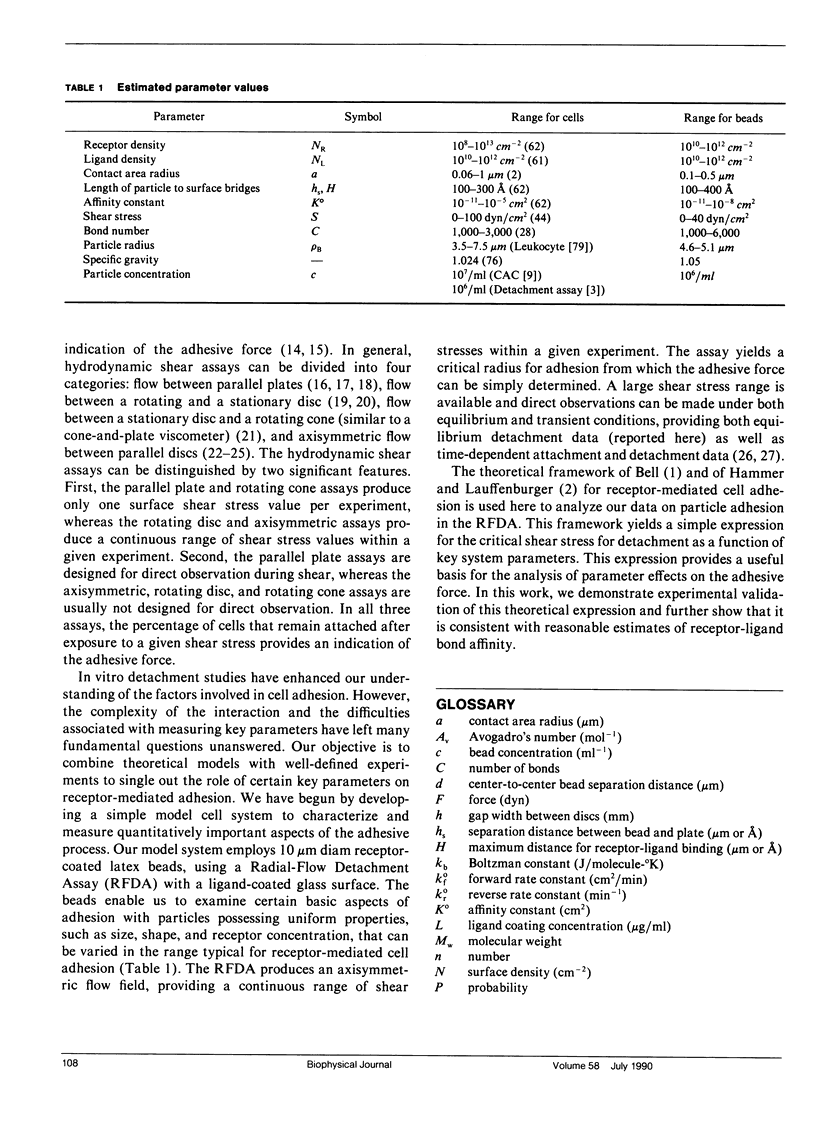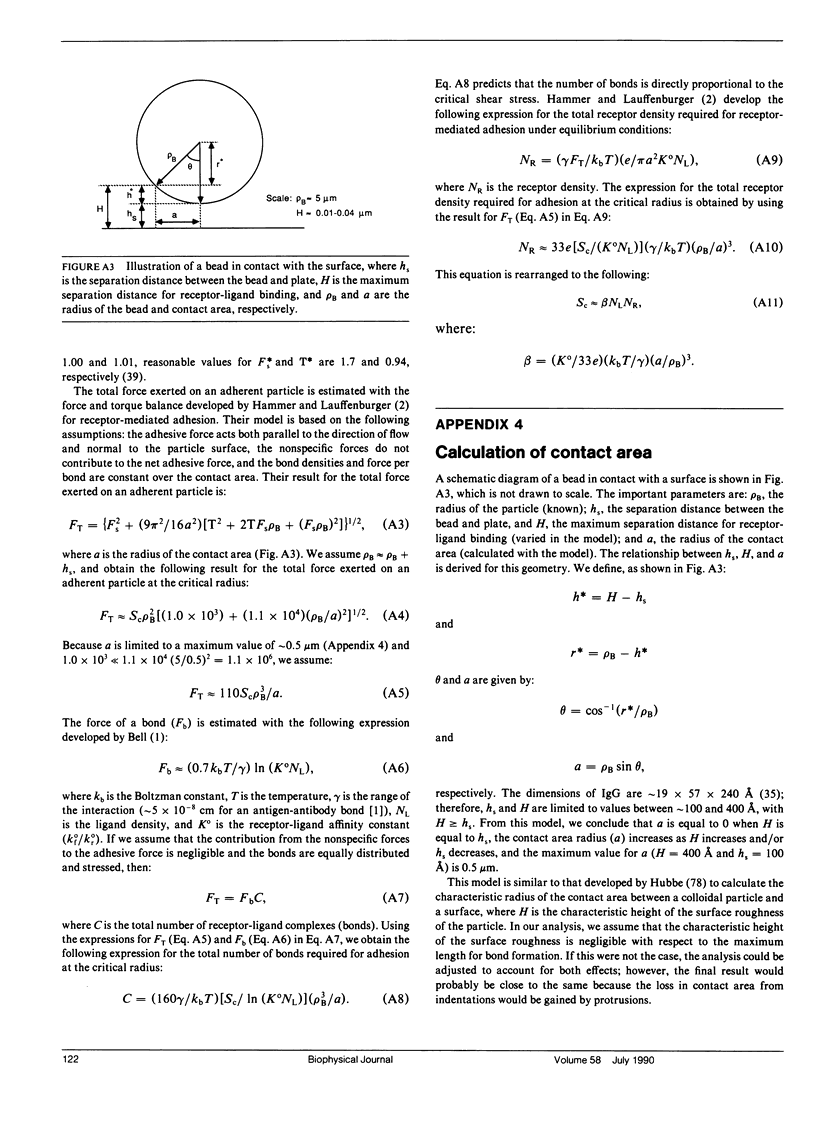Abstract
Receptor-mediated cell adhesion phenomena play a vital role in many physiological and biotechnology-related processes. To investigate the physical and chemical factors that influence the cell/surface interaction, we have used a radial flow device, a so-called Radial-Flow Detachment Assay (RFDA). The RFDA allows us to make direct observations of the detachment process under specified experimental conditions. In results reported here, we have studied the detachment of receptor-coated latex beads (prototype cells) from ligand-coated glass surfaces. The receptors and ligands used in this work are complementary antibodies. The beads enable us to examine several aspects of the adhesion process with particles having uniform properties that can be varied systematically. Advantages of the RFDA are many, especially direct observation of cell detachment over a range of shear stresses with quantitative measurement of the adhesive force. We focus our studies on the effects of ligand and receptor densities, along with the influence of pH and ionic strength of the medium. These data are analyzed with a mathematical model based on the theoretical framework of Bell, G. I. (1978. Science [Wash. DC]. 200:618-627) and Hammer, D. A. and D. A. Lauffenburger (1987. Biophys. J. 52:475-487). We demonstrate experimental validation of a theoretical expression for the critical shear stress for particle detachment, and show that it is consistent with reasonable estimates for the receptor-ligand bond affinity.
Full text
PDF


















Images in this article
Selected References
These references are in PubMed. This may not be the complete list of references from this article.
- Anderson J. M. Inflammatory response to implants. ASAIO Trans. 1988 Apr-Jun;34(2):101–107. doi: 10.1097/00002480-198804000-00005. [DOI] [PubMed] [Google Scholar]
- Atherton A., Born G. V. Quantitative investigations of the adhesiveness of circulating polymorphonuclear leucocytes to blood vessel walls. J Physiol. 1972 Apr;222(2):447–474. doi: 10.1113/jphysiol.1972.sp009808. [DOI] [PMC free article] [PubMed] [Google Scholar]
- Barabino G. A., McIntire L. V., Eskin S. G., Sears D. A., Udden M. Endothelial cell interactions with sickle cell, sickle trait, mechanically injured, and normal erythrocytes under controlled flow. Blood. 1987 Jul;70(1):152–157. [PubMed] [Google Scholar]
- Bell G. I., Dembo M., Bongrand P. Cell adhesion. Competition between nonspecific repulsion and specific bonding. Biophys J. 1984 Jun;45(6):1051–1064. doi: 10.1016/S0006-3495(84)84252-6. [DOI] [PMC free article] [PubMed] [Google Scholar]
- Bell G. I. Models for the specific adhesion of cells to cells. Science. 1978 May 12;200(4342):618–627. doi: 10.1126/science.347575. [DOI] [PubMed] [Google Scholar]
- Berenson R. J., Levitt L. J., Levy R., Miller R. A. Cellular immunoabsorption using monoclonal antibodies. Selective removal of T cells from peripheral blood and bone marrow. Transplantation. 1984 Aug;38(2):136–142. [PubMed] [Google Scholar]
- Berke G. Cytotoxic T-lymphocytes. How do they function? Immunol Rev. 1983;72:5–42. doi: 10.1111/j.1600-065x.1983.tb01071.x. [DOI] [PubMed] [Google Scholar]
- Bongrand P., Capo C., Benoliel A. M., Depieds R. Evaluation of intercellular adhesion with a very simple technique. J Immunol Methods. 1979;28(1-2):133–141. doi: 10.1016/0022-1759(79)90335-1. [DOI] [PubMed] [Google Scholar]
- Burridge K., Fath K., Kelly T., Nuckolls G., Turner C. Focal adhesions: transmembrane junctions between the extracellular matrix and the cytoskeleton. Annu Rev Cell Biol. 1988;4:487–525. doi: 10.1146/annurev.cb.04.110188.002415. [DOI] [PubMed] [Google Scholar]
- Butcher E. C., Scollay R. G., Weissman I. L. Organ specificity of lymphocyte migration: mediation by highly selective lymphocyte interaction with organ-specific determinants on high endothelial venules. Eur J Immunol. 1980 Jul;10(7):556–561. doi: 10.1002/eji.1830100713. [DOI] [PubMed] [Google Scholar]
- Capo C., Garrouste F., Benoliel A. M., Bongrand P., Ryter A., Bell G. I. Concanavalin-A-mediated thymocyte agglutination: a model for a quantitative study of cell adhesion. J Cell Sci. 1982 Aug;56:21–48. doi: 10.1242/jcs.56.1.21. [DOI] [PubMed] [Google Scholar]
- Chin Y. H., Rasmussen R., Cakiroglu A. G., Woodruff J. J. Lymphocyte recognition of lymph node high endothelium. VI. Evidence of distinct structures mediating binding to high endothelial cells of lymph nodes and Peyer's patches. J Immunol. 1984 Dec;133(6):2961–2965. [PubMed] [Google Scholar]
- Crothers D. M., Metzger H. The influence of polyvalency on the binding properties of antibodies. Immunochemistry. 1972 Mar;9(3):341–357. doi: 10.1016/0019-2791(72)90097-3. [DOI] [PubMed] [Google Scholar]
- Dejana E., Colella S., Languino L. R., Balconi G., Corbascio G. C., Marchisio P. C. Fibrinogen induces adhesion, spreading, and microfilament organization of human endothelial cells in vitro. J Cell Biol. 1987 May;104(5):1403–1411. doi: 10.1083/jcb.104.5.1403. [DOI] [PMC free article] [PubMed] [Google Scholar]
- EASTY G. C., EASTY D. M., AMBROSE E. J. Studies of cellular adhesiveness. Exp Cell Res. 1960 Apr;19:539–548. doi: 10.1016/0014-4827(60)90062-8. [DOI] [PubMed] [Google Scholar]
- Edelman G. M., Rutishauser U., Millette C. F. Cell fractionation and arrangement on fibers, beads, and surfaces. Proc Natl Acad Sci U S A. 1971 Sep;68(9):2153–2157. doi: 10.1073/pnas.68.9.2153. [DOI] [PMC free article] [PubMed] [Google Scholar]
- Eskin S. G., Ives C. L., McIntire L. V., Navarro L. T. Response of cultured endothelial cells to steady flow. Microvasc Res. 1984 Jul;28(1):87–94. doi: 10.1016/0026-2862(84)90031-1. [DOI] [PubMed] [Google Scholar]
- Evans E. A. Minimum energy analysis of membrane deformation applied to pipet aspiration and surface adhesion of red blood cells. Biophys J. 1980 May;30(2):265–284. doi: 10.1016/S0006-3495(80)85093-4. [DOI] [PMC free article] [PubMed] [Google Scholar]
- Evans E., Leung A. Adhesivity and rigidity of erythrocyte membrane in relation to wheat germ agglutinin binding. J Cell Biol. 1984 Apr;98(4):1201–1208. doi: 10.1083/jcb.98.4.1201. [DOI] [PMC free article] [PubMed] [Google Scholar]
- Forrester J. V., Lackie J. M. Adhesion of neutrophil leucocytes under conditions of flow. J Cell Sci. 1984 Aug;70:93–110. doi: 10.1242/jcs.70.1.93. [DOI] [PubMed] [Google Scholar]
- Gingell D., Todd I. Red blood cell adhesion. II. Interferometric examination of the interaction with hydrocarbon oil and glass. J Cell Sci. 1980 Feb;41:135–149. doi: 10.1242/jcs.41.1.135. [DOI] [PubMed] [Google Scholar]
- Groves B. J., Riley P. A. A miniaturised parallel-plate shearing apparatus for the measurement of cell adhesion. Cytobios. 1987;52(208):49–62. [PubMed] [Google Scholar]
- HUGHES-JONES N. C., GARDNER B., TELFORD R. THE EFFECT OF PH AND IONIC STRENGTH ON THE REACTION BETWEEN ANTI-D AND ERYTHROCYTES. Immunology. 1964 Jan;7:72–81. [PMC free article] [PubMed] [Google Scholar]
- Hafeman D. G., von Tscharner V., McConnell H. M. Specific antibody-dependent interactions between macrophages and lipid haptens in planar lipid monolayers. Proc Natl Acad Sci U S A. 1981 Jul;78(7):4552–4556. doi: 10.1073/pnas.78.7.4552. [DOI] [PMC free article] [PubMed] [Google Scholar]
- Hammer D. A., Lauffenburger D. A. A dynamical model for receptor-mediated cell adhesion to surfaces. Biophys J. 1987 Sep;52(3):475–487. doi: 10.1016/S0006-3495(87)83236-8. [DOI] [PMC free article] [PubMed] [Google Scholar]
- Hughes R. C., Pena S. D., Clark J., Dourmashkin R. R. Molecular requirements for adhesion and spreading of hamster fibroblasts. Exp Cell Res. 1979 Jul;121(2):307–314. doi: 10.1016/0014-4827(79)90009-0. [DOI] [PubMed] [Google Scholar]
- Jauregui H. O. Cell adhesion to biomaterials. The role of several extracellular matrix components in the attachment of non-transformed fibroblasts and parenchymal cells. ASAIO Trans. 1987 Apr-Jun;33(2):66–74. [PubMed] [Google Scholar]
- Lauffenburger D., DeLisi C. Cell surface receptors: physical chemistry and cellular regulation. Int Rev Cytol. 1983;84:269–302. doi: 10.1016/s0074-7696(08)61020-7. [DOI] [PubMed] [Google Scholar]
- Lawrence M. B., McIntire L. V., Eskin S. G. Effect of flow on polymorphonuclear leukocyte/endothelial cell adhesion. Blood. 1987 Nov;70(5):1284–1290. [PubMed] [Google Scholar]
- Liao N. S., St John J., Du Z. J., Cheung H. T. Adhesion of lymphoid cell lines to fibronectin-coated substratum: biochemical and physiological characterization and the identification of a 140-kDa fibronectin receptor. Exp Cell Res. 1987 Aug;171(2):306–320. doi: 10.1016/0014-4827(87)90164-9. [DOI] [PubMed] [Google Scholar]
- McClay D. R., Wessel G. M., Marchase R. B. Intercellular recognition: quantitation of initial binding events. Proc Natl Acad Sci U S A. 1981 Aug;78(8):4975–4979. doi: 10.1073/pnas.78.8.4975. [DOI] [PMC free article] [PubMed] [Google Scholar]
- Mege J. L., Capo C., Benoliel A. M., Bongrand P. Determination of binding strength and kinetics of binding initiation. A model study made on the adhesive properties of P388D1 macrophage-like cells. Cell Biophys. 1986 Apr;8(2):141–160. doi: 10.1007/BF02788478. [DOI] [PubMed] [Google Scholar]
- Molday R. S., Dreyer W. J., Rembaum A., Yen S. P. New immunolatex spheres: visual markers of antigens on lymphocytes for scanning electron microscopy. J Cell Biol. 1975 Jan;64(1):75–88. doi: 10.1083/jcb.64.1.75. [DOI] [PMC free article] [PubMed] [Google Scholar]
- Nyilas E., Morton W. A., Lederman D. M., Chiu T. H., Cumming R. D. Interdependence of hemodynamic and surface parameters in thrombosis. Trans Am Soc Artif Intern Organs. 1975;21:55–70. [PubMed] [Google Scholar]
- Pecht I., Lancet D. Kinetics of antibody-hapten interactions. Mol Biol Biochem Biophys. 1977;24:306–338. doi: 10.1007/978-3-642-81117-3_9. [DOI] [PubMed] [Google Scholar]
- Perelson A. S., Goldstein B., Rocklin S. Optimal strategies in immunology III. The IgM-IgG switch. J Math Biol. 1980 Nov;10(3):209–256. doi: 10.1007/BF00276984. [DOI] [PubMed] [Google Scholar]
- Pratt K. J., Jarrell B. E., Williams S. K., Carabasi R. A., Rupnick M. A., Hubbard F. A. Kinetics of endothelial cell-surface attachment forces. J Vasc Surg. 1988 Apr;7(4):591–599. [PubMed] [Google Scholar]
- Rutishauser U., Sachs L. Cell-to-cell binding induced by different lectins. J Cell Biol. 1975 May;65(2):247–257. doi: 10.1083/jcb.65.2.247. [DOI] [PMC free article] [PubMed] [Google Scholar]
- Rutishauser U., Sachs L. Receptor mobility and the binding of cells to lectin-coated fibers. J Cell Biol. 1975 Jul;66(1):76–85. doi: 10.1083/jcb.66.1.76. [DOI] [PMC free article] [PubMed] [Google Scholar]
- Rutishauser U., Sachs L. Receptor mobility and the mechanism of cell-cell binding induced by concanavalin A. Proc Natl Acad Sci U S A. 1974 Jun;71(6):2456–2460. doi: 10.1073/pnas.71.6.2456. [DOI] [PMC free article] [PubMed] [Google Scholar]
- Schmid-Schoenbein G. W., Fung Y. C., Zweifach B. W. Vascular endothelium-leukocyte interaction; sticking shear force in venules. Circ Res. 1975 Jan;36(1):173–184. doi: 10.1161/01.res.36.1.173. [DOI] [PubMed] [Google Scholar]
- Seeger R. C., Vo D. D., Ugelstad J., Reynolds C. P. Removal of neuroblastoma cells from bone marrow with monoclonal antibodies and magnetic immunobeads. Prog Clin Biol Res. 1986;211:285–293. [PubMed] [Google Scholar]
- Sung K. L., Sung L. A., Crimmins M., Burakoff S. J., Chien S. Determination of junction avidity of cytolytic T cell and target cell. Science. 1986 Dec 12;234(4782):1405–1408. doi: 10.1126/science.3491426. [DOI] [PubMed] [Google Scholar]
- Thomas P. D., Hampson F. W., Casale J. M., Hunninghake G. W. Neutrophil adherence to human endothelial cells. J Lab Clin Med. 1988 Mar;111(3):286–292. [PubMed] [Google Scholar]
- WEISS L. The measurement of cell adhesion. Exp Cell Res. 1961;Suppl 8:141–153. doi: 10.1016/0014-4827(61)90345-7. [DOI] [PubMed] [Google Scholar]
- Weetall H. H. Covalent coupling methods for inorganic support materials. Methods Enzymol. 1976;44:134–148. doi: 10.1016/s0076-6879(76)44012-0. [DOI] [PubMed] [Google Scholar]
- Werblin T. P., Siskind G. W. Distribution of antibody affinities: technique of measurement. Immunochemistry. 1972 Oct;9(10):987–1011. doi: 10.1016/0019-2791(72)90110-3. [DOI] [PubMed] [Google Scholar]
- Wilkinson P. C., Lackie J. M., Forrester J. V., Dunn G. A. Chemokinetic accumulation of human neutrophils on immune complex-coated substrata: analysis at a boundary. J Cell Biol. 1984 Nov;99(5):1761–1768. doi: 10.1083/jcb.99.5.1761. [DOI] [PMC free article] [PubMed] [Google Scholar]
- Worthen G. S., Smedly L. A., Tonnesen M. G., Ellis D., Voelkel N. F., Reeves J. T., Henson P. M. Effects of shear stress on adhesive interaction between neutrophils and cultured endothelial cells. J Appl Physiol (1985) 1987 Nov;63(5):2031–2041. doi: 10.1152/jappl.1987.63.5.2031. [DOI] [PubMed] [Google Scholar]
- de Groot E. R., Lamers M. C., Aarden L. A., Smeenk R. J., van Oss C. J. Dissociation of DNA/anti-DNA complexes at high pH. Immunol Commun. 1980;9(5):515–528. doi: 10.3109/08820138009066012. [DOI] [PubMed] [Google Scholar]
- van Oss C. J., Absolom D. R., Grossberg A. L., Neumann A. W. Repulsive van der Waals forces. I. Complete dissociation of antigen-antibody complexes by means of negative van der Waals forces. Immunol Commun. 1979;8(1):11–29. doi: 10.3109/08820137909044703. [DOI] [PubMed] [Google Scholar]
- von Tscharner V., McConnell H. M. Physical properties of lipid monolayers on alkylated planar glass surfaces. Biophys J. 1981 Nov;36(2):421–427. doi: 10.1016/S0006-3495(81)84741-8. [DOI] [PMC free article] [PubMed] [Google Scholar]



